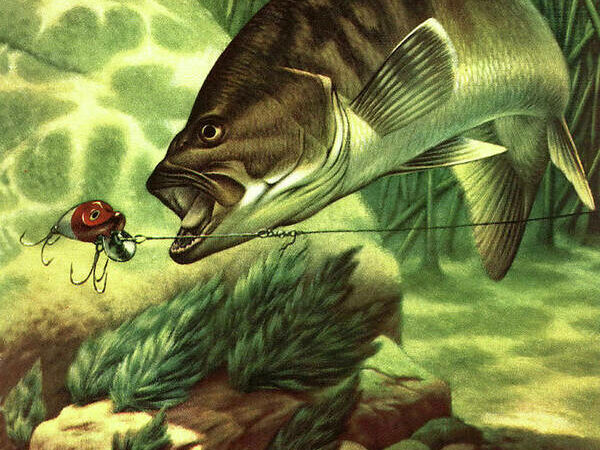Why You Should Eat Fried Fish Tails
I wish I could say that I’m about to clue you in to a culinary treat that me and my family have been enjoying for years, but that’s simply not the case. I ate my first fried fish tail just a week before penning this column. For some of you, nibbling on crispy, crunchy fins is old news, but despite that fact that I’ve been eating fish my entire life, all the fins went in the trash can prior to a recent nudge from a guest on my podcast who knows a lot more than me about getting the best yield from your catch.
.embed-container { position: relative; padding-bottom: 56.25%; height: 0; overflow: hidden; max-width: 100%; } .embed-container iframe, .embed-container object, .embed-container embed { position: absolute; top: 0; left: 0; width: 100%; height: 100%; }
Reed Brand — better known as “Reedthefishmonger” — has racked up an impressive following on YouTube and Instagram. His family owns Captain Clay and Sons Seafood Market in Delray Beach, Florida, and Brand’s highly educational and rather addicting fish-processing videos have caught fire on social media. The first video he ever posted on YouTube was a fish tail taste test. Brand crisps up a variety of tails ranging from salmon to cod to tilefish in the oven and assesses their flavors and textures. When I questioned Brand about tail consumption, he quickly made it clear that I’ve been missing out. So, I vowed to get-in-the-know. Here’s what I learned.
It’s Not That Weird
According to Brand (and several other podcast listeners that reached out after the show aired) eating fish tails is extremely common in many cultures, particularly those that tend to cook fish whole as opposed to only eating boneless fillets. In fact, Brand says in many island cultures, as an example, tails are often fought over in the family since they’re considered a real treat — like how you or I might squabble over who gets the crispiest piece of skin from a roasted chicken. Before you judge me for not being more in tune with tail eating, I will openly admit that I was never a huge fan of whole fish preparations. For better or worse, I’m not the guy who orders the whole fried snapper at the Cuban restaurant or the whole steamed fish at the Japanese joint. I’ve eaten loads of fish cheeks, throats, and “wings,” but never a tail. Brand, however, insisted that when prepared properly, they’re like a fishy, briny potato chip. The trick is choosing the right tails to fry.
Size Matters
You can eat the tails from any fish caught in salt- or freshwater, but keep in mind that the objective is for the end products to crunch and breakdown like a potato chip in your mouth. With the tails from larger fish, say a striped bass or salmon, the thicker fin rays within that tail will make it difficult to consume the entire thing down to the base. You’ll get a few choice bites off the thinner leading edge, but not much more. Meanwhile, smaller fish with overall thinner tails provide a snack that you can pop and munch like Pringles. Brand noted that fish with longer, flowing fin rays have some of the best tails for frying. According to him, in my Northeast neck of the woods, black sea bass provide the finest tail eats. My listeners also let me know that trout and perch tails fry up very nicely.
The Taste Test
A man of my word, I promised Brand I’d give fish tails a shake, and my plan was to start with flounder tails. The only problem was that my last two flounder runs at the Jersey Shore were pretty weak. I’m good at making lemonade, though — especially with a 6-year-old kid on board — so we switched gears and went after the piles of croaker and spot that flood the bay in summer. Though these little fish are a pain to fillet, my son wanted them for dinner and I obliged. Their tails weren’t big, but they were nice and thin, so I reserved them at the cleaning table and decided to make “chips.”
Brand says it’s hard to beat a fish tail fried in bacon fat, but I went with olive oil. I made a simple mixture of flour and Old Bay seasoning and gave the tails a quick dredge. Since posting a video of the results on Instagram, I’ve learned that some people believe no flour coating is necessary though Brand feels it adds some extra crunch and flavor and I tend to agree.
I learned fast that you have to monitor the heat closely because small tails fry fast. A little charring is good thing, but they’ll over blacken in no time if you’re not paying attention. My croaker tails came out gold and brown and I understood why so many people eat them after the first bite. The tail had all the crunch of a potato chip and a nearly identical mouth feel. The flavor, however, was unique. You know you’re eating fish but it’s a muted undertone. Maybe the better way to put it is you know you’re eating seafood, but there was nothing glaringly fishy about the flavor. In fact, I’d even call it nutty. Granted, the flavor will change based on the species you’re getting your tails from, but I’m a convert. My son and father-in-law even took a reluctant bite and both were pleasantly surprised.
My kid, of course, wanted more but given that this was just an experiment, I only fried a precious five. He’ll have to catch more croakers next time and maybe I’ll even grab a shaker of sour cream and onion seasoning for him. It’s his favorite chip flavor.
The post Why You Should Eat Fried Fish Tails appeared first on Outdoor Life.
Source: https://www.outdoorlife.com/fishing/eating-fried-fish-tails/




